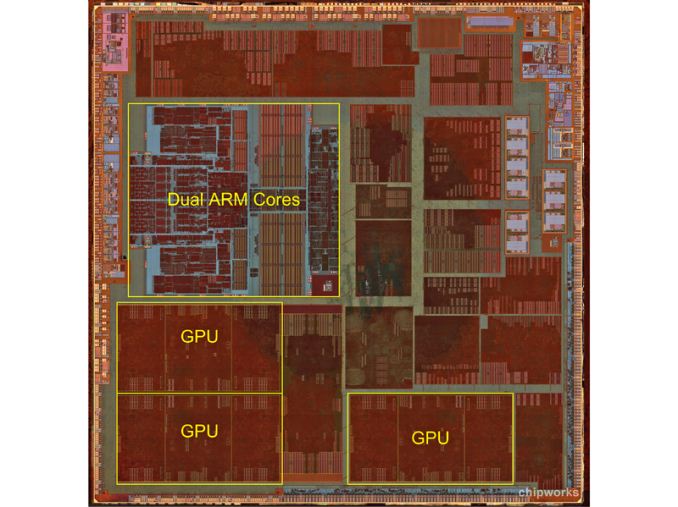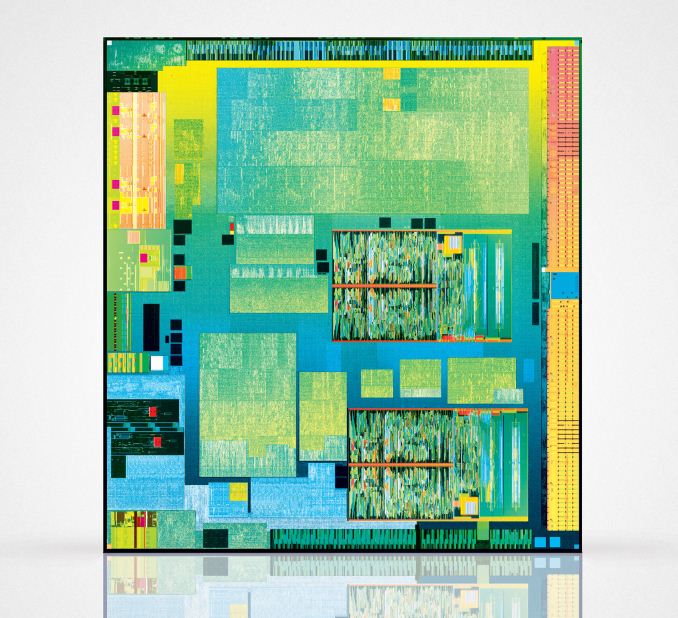Sunday, September 22, 2013 12:53:21 PM
http://www.anandtech.com/show/7355/chipworks-provides-first-apple-a7-die-shot
Below are A7 (28nm), then A6 (32nm), then Bay Trail (22nm) for comparison. I did some quick measurements in mspaint, for those who are interested. All sizes are normalized to 22nm. Conversion is 0.7^2 for 32nm-->22nm, and 0.9^2 for 32nm-->28nm. The CPU includes all the cores and all the cache, while the GPU includes all of the regular arrays that can be seen in the die shot, but probably misses fixed function media, etc, which are likely in other areas around the primary graphics arrays.
Die size of Bay Trail is in the datasheet (102mm2), last page, if you zoom in on coordinates C1 (9.723mm) and C2 (10.477mm).
http://www.intel.com/content/dam/www/public/us/en/documents/datasheets/atom-z36xxx-z37xxx-datasheet-vol-1.pdf
Die Size CPU Size Normalized GPU Size Normalized
A7 102mm2 17.8mm2 10.77mm2 23.2mm2 14.0mm2
A6 97mm2 15.2mm2 7.45mm2 20.4mm2 10.0mm2
Bay Trail 102mm2 17.1mm2 17.10mm2 18.6mm2 18.6mm2
- Given that Bay Trail has 2x as many cores, I can understand how normalized CPU area ended up 60% larger than A7. Still, with performance less than 60% faster, Apple clearly has better perf/area efficiency.
- The normalized GPU area does suggest that Bay Trail's graphics are also less efficient, but part of that does include the significant overhead to enable DX11 (and from what I recall, Imagination 6-series does not). This is important under Windows, but does not currently get used under iOS. However, Android will eventually support OpenGL-ES 3.0, which will probably use the same functional transistors, and so Intel will likely be able to support those features, and overall improved graphics rendering quality.
Overall, it does appear that Apple achieved both a very high performance design, as well as a fairly area efficient design. You can also see that the normalized growth over A6 (44% on CPU and 40% on GPU) is pretty nominal, given the generational performance increase. Performance per area has gone up dramatically, and given the half-process shrink to 28nm, was nearly washed out.
Intel will need to step up their game. While I think Bay Trail will still win in the Android and Windows ecosystems, I'm hoping the 14nm generation products get the improvements in density needed to be the market leader.



Recent INTC News
- Intel Unveils Next-Generation AI Solutions with the Launch of Xeon 6 and Gaudi 3 • Business Wire • 09/24/2024 03:00:00 PM
- U.S. Stocks May See Further Upside In Early Trading • IH Market News • 09/24/2024 01:07:11 PM
- U.S. Index Futures Rise Slightly; Oil Prices Surge Amid China Stimulus and Gulf of Mexico Hurricane • IH Market News • 09/24/2024 10:17:29 AM
- Apollo Eyes $5 Billion Investment in Intel; TSMC and Samsung Explore UAE Chip Projects, and More • IH Market News • 09/23/2024 10:32:25 AM
- Flapmax Expands Collaboration with Intel to Launch Quantum AI Challenge • PR Newswire (US) • 09/20/2024 04:12:00 PM
- Remark AI Successfully Optimized on Intel Architecture • PR Newswire (US) • 09/17/2024 01:00:00 PM
- Microsoft Boosts Share Buyback, Raises Dividends by 10%, Intel Secures Chip Deal with Amazon • IH Market News • 09/17/2024 10:40:35 AM
- Intel and AWS Expand Strategic Collaboration, Helping Advance U.S.-Based Chip Manufacturing • Business Wire • 09/16/2024 08:01:00 PM
- Intel Awarded up to $3B by the Biden-Harris Administration for Secure Enclave • Business Wire • 09/16/2024 06:02:00 PM
- Intel Secures $3.5 Billion Subsidy, Stellantis Backs EU Emissions Targets, BP and Apollo Reach $1 Billion Deal • IH Market News • 09/16/2024 10:03:27 AM
- Broadcom Down 10% Post-Earnings, UiPath Up 8%; Qualcomm Eyes Intel Assets; Salesforce Acquires Own Company • IH Market News • 09/06/2024 11:59:00 AM
- Qualcomm Develops Mixed Reality Glasses; Verizon to Boost Dividend, Eyes Acquisition; Samsonite Plans US Dual Listing • IH Market News • 09/05/2024 10:11:35 AM
- Form 4 - Statement of changes in beneficial ownership of securities • Edgar (US Regulatory) • 09/04/2024 11:38:13 PM
- U.S. Index Futures Fall Amid Market Volatility; Oil Prices Drop on Libya Dispute, Weak Global Demand • IH Market News • 09/04/2024 09:52:47 AM
- Nvidia Subpoenaed by DOJ, Athira Pharma Shares Plunge 71% After Study Fails, Zscaler Falls 15% Post-Earnings • IH Market News • 09/04/2024 09:50:25 AM
- New Core Ultra Processors Deliver Breakthrough Performance, Efficiency for the AI PC Age • Business Wire • 09/03/2024 04:00:00 PM
- Futures Pointing To Initial Pullback On Wall Street • IH Market News • 09/03/2024 01:10:07 PM
- U.S. Stocks Fluctuate Before Closing Sharply Higher • IH Market News • 08/30/2024 08:44:00 PM
- Intuitive Machines Soars 18% on NASA Contract, Intel Considers Splitting Operations, Dell Reassesses Selling SecureWorks • IH Market News • 08/30/2024 10:00:08 AM
- Big Lots Falls 27%, Considers Bankruptcy; DraftKings Acquires Simplebet, Berkshire Hits $1 Trillion • IH Market News • 08/29/2024 10:06:50 AM
- Nvidia Shares Fall Despite More Than Doubling Sales • IH Market News • 08/29/2024 08:36:37 AM
- High Volatility Expected in Nvidia Report, Ambarella Soars 20%, Hertz Strengthens Board, Apple Cuts Jobs • IH Market News • 08/28/2024 09:50:36 AM
- Form N-PX - Annual Report of proxy voting record of management investment companies • Edgar (US Regulatory) • 08/27/2024 07:47:19 PM
- IBM Closes China Research Division, Uber Fined $324M, Starliner to Return Without Astronauts • IH Market News • 08/26/2024 12:58:21 PM
- Cruise and Uber Join Forces for Robotaxis, Alibaba Shifts Primary Listing to Hong Kong, Altria Hikes Dividend 4.1% • IH Market News • 08/23/2024 12:20:26 PM
FEATURED Cannabix Technologies and Omega Laboratories Inc. Advance Marijuana Breathalyzer Technology - Dr. Bruce Goldberger to Present at Society of Forensic Toxicologists Conference • Sep 24, 2024 8:50 AM
FEATURED Integrated Ventures, Inc Announces Strategic Partnership For GLP-1 (Semaglutide) Procurement Through MedWell USA, LLC. • Sep 24, 2024 8:45 AM
Avant Technologies Accelerates Creation of AI-Powered Platform to Revolutionize Patient Care • AVAI • Sep 24, 2024 8:00 AM
VHAI - Vocodia Partners with Leading Political Super PACs to Revolutionize Fundraising Efforts • VHAI • Sep 19, 2024 11:48 AM
Dear Cashmere Group Holding Co. AKA Swifty Global Signs Binding Letter of Intent to be Acquired by Signing Day Sports • DRCR • Sep 19, 2024 10:26 AM
HealthLynked Launches Virtual Urgent Care Through Partnership with Lyric Health. • HLYK • Sep 19, 2024 8:00 AM







